Executive summary
Discover the power of contact center analytics in transforming customer service into a strategic asset. This blog dives into how analytics solutions can refine call center operations, boost customer satisfaction, and enhance overall business performance. Learn about the different types of contact center analytics, their crucial role in strategic decision-making, and how they drive efficiency and customer loyalty.
Introduction
Contact center analytics emerges as a game-changer in customer service. It turns every customer interaction into a learning opportunity. With 66% of call centers planning to invest in this technology, the trend is clear: data-driven insights are crucial to elevating customer experiences and operational success. This blog will walk you through the intricate world of contact center analytics, highlighting its significance in crafting exceptional customer journeys and boosting organizational efficiency.
The synergy between AI technology and contact center operations is reshaping how businesses approach customer engagement. By translating complex data into coherent, actionable insights, companies can pinpoint areas for improvement. Furthermore, it can help businesses tailor services to customer needs and, ultimately, craft experiences that resonate and retain. As we explore more on contact center analytics, we will understand and examine the layers of contact center analytics. We will illustrate its pivotal role in sculpting a data-driven pathway to customer satisfaction and business success.
Related must-reads:
- Contact center services: Types, benefits and tips for managing
- Contact center experience: Types + Ways to improve
- Contact center outsourcing – Benefits & challenges
- Contact center automation: Revolutionize your customer service
What is contact center analytics?
Contact center analytics is about digging into the data from customer interactions to make better business decisions. It’s the behind-the-scenes work in places where customers call, email, or chat to get help or buy something. This analytics turns raw data into useful info, showing what’s working and what’s not in customer service.
Think of it as the control center for customer interactions. By analyzing things like call duration, customer feedback, and problem resolution speed, businesses can pinpoint what needs improvement. This process helps make services faster, more helpful, and more in tune with customers’ needs.
In simple terms, contact center analytics helps businesses understand their customers better. It uses data to spot trends, fix issues, and improve overall service. This way, companies can keep customers happy, cut costs, and boost their bottom line. It’s about handling calls better and ensuring every customer interaction adds value. That leads to loyal customers and a thriving business.
Types of contact center analytics
Understanding the types of analytics available can be crucial in contact center operations. Here’s a breakdown of the key types of contact center analytics and how they can benefit businesses:
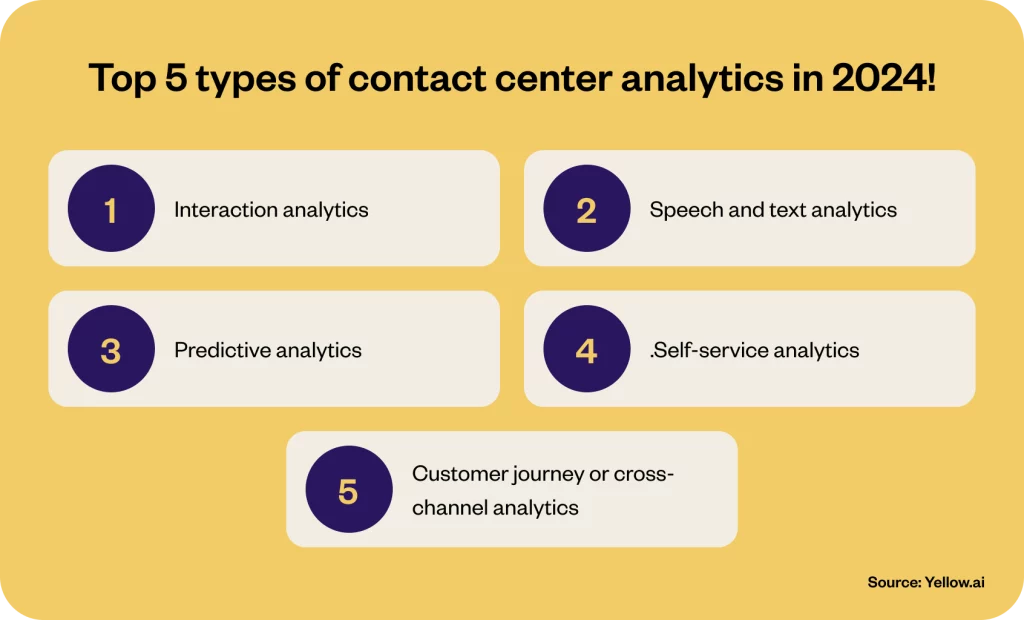
Interaction analytics:
This type analyzes the metadata of customer interactions, such as call durations, hold times, and resolution rates. Businesses can pinpoint efficiency gaps in agent performance and operational workflows by examining these elements. Interaction analytics help optimize call-handling processes and enhance customer service efficiency.
Speech and text analytics:
Delving into the content of communications, speech, and text analytics examine the actual words and sentiments expressed in calls, emails, and chats. This type reveals customer sentiments, prevalent issues, and agent performance in adhering to protocols. It’s essential for understanding the nuances of customer interactions and refining communication strategies.
Predictive analytics:
Utilizing AI and machine learning, predictive analytics forecasts customer behavior and preferences. This proactive approach allows businesses to anticipate customer needs, streamline operations for peak times, and identify upsell opportunities. It’s about staying ahead of customer demands and enhancing service proactively.
Self-service analytics:
Focusing on customer-initiated interactions, self-service analytics evaluates the effectiveness of automated channels like chatbots and FAQs. Insights from this analysis help improve self-service resources, leading to faster resolutions for customers and reduced workload for agents.
Related read: Self customer service: Navigating the new era of empowered consumers
Customer journey or cross-channel analytics:
This comprehensive approach merges data from various customer touchpoints to paint a complete picture of the customer journey. It helps identify bottlenecks and improve the customer experience across all channels. By understanding the customer’s path, businesses can streamline interactions and direct customers to the most effective resolution paths.
Why is contact center analytics so important?
Understanding the importance of contact center analytics is critical for businesses aiming to enhance their customer experience and operational efficiency. Here’s why it’s indispensable in today’s data-driven business environment:
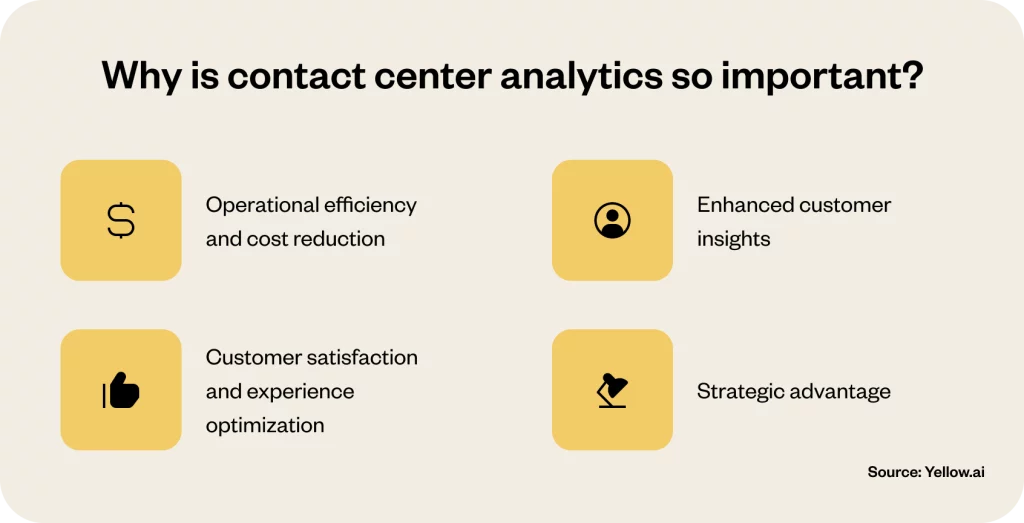
1. Operational efficiency and cost reduction
Contact center analytics play a pivotal role in streamlining operations and cutting costs. Businesses can identify and improve inefficiencies by analyzing metrics like average handle time and call resolution rates. McKinsey’s findings suggest that effective analytics usage can slash average handle time by up to 40% and reduce employee costs significantly. They demonstrate the substantial financial impact of these insights.
2. Enhanced customer insights
Analytics fill the gap left by insufficient customer survey responses, offering a reliable data source for strategic decision-making. They provide a comprehensive view of customer interactions across all channels, revealing insights into customer behavior and preferences. This data is crucial for understanding the nuances of customer experiences, enabling businesses to make informed amendments and revisions.
3. Customer satisfaction and experience optimization
By leveraging analytics, companies gain a holistic view of the customer journey, identifying pain points and opportunities for enhancement. This proactive approach allows customer experience optimization, leading to increased satisfaction and loyalty. Analytics helps pinpoint issues before they escalate, facilitating a more seamless and enjoyable customer journey.
Related read: How can customer journey maps improve customer experiences?
4. Strategic advantage
A well-managed contact center, informed by analytics, becomes a strategic asset. It differentiates a business from competitors by providing superior customer service. In today’s market, where customer experience often dictates loyalty, a data-driven contact center can be a significant differentiator, encouraging customers to choose your brand over others.
Contact center analytics best practices
To harness the full potential of contact center analytics, businesses must adopt a strategic approach that transcends conventional performance metrics. Here are some best practices to guide your journey toward a data-driven contact center operation:
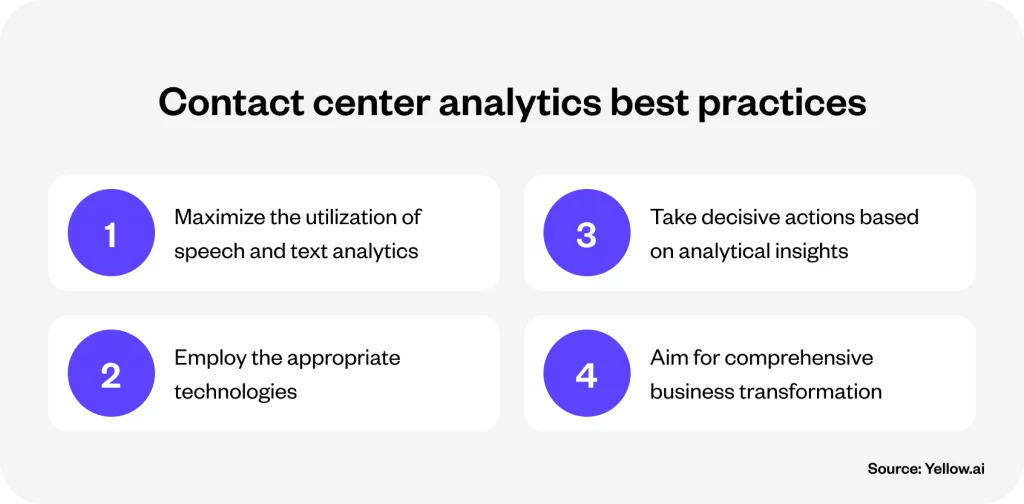
1. Maximize the utilization of speech and text analytics
Harness the power of speech and text analytics to comprehensively understand customer interactions. By analyzing voice calls and text-based communications, businesses can identify trends, sentiments, and areas for improvement. Integrating these analytics helps in creating a unified strategy to enhance customer service and streamline processes. For instance, analyzing call transcripts can reveal common customer issues that, once addressed, can significantly reduce call volumes and improve satisfaction.
2. Employ the appropriate technologies
It is vital to select the right tools for contact center analytics. These tools should manage large volumes of data and provide deep, actionable insights. An integrated analytics platform can bridge the gap between different data sources, offering a holistic view of customer interactions. This integration ensures that insights are comprehensive and can be strategically used for business improvement.
3. Take decisive actions based on analytical insights
Insights gained from analytics should lead to concrete actions. It’s not enough to have data; the real value comes from applying these insights to enhance customer experience and streamline operations. Whether it’s addressing individual customer issues promptly or making strategic changes in the contact center process, the goal is to use analytics to inform and guide actionable improvements.
4. Aim for comprehensive business transformation
While improving individual metrics like call handling time or customer satisfaction is important, the ultimate goal should be using analytics for overall business transformation. Contact center analytics should inform broader business strategies, helping to refine processes and improve customer engagement across all touchpoints. This holistic approach ensures that analytics drive incremental improvements and contribute to significant, long-term business success.
How do you use contact center analytics to track performance?
Using contact center analytics effectively to track performance is crucial for any business aiming to improve its customer service operations. Here’s how to do it effectively:
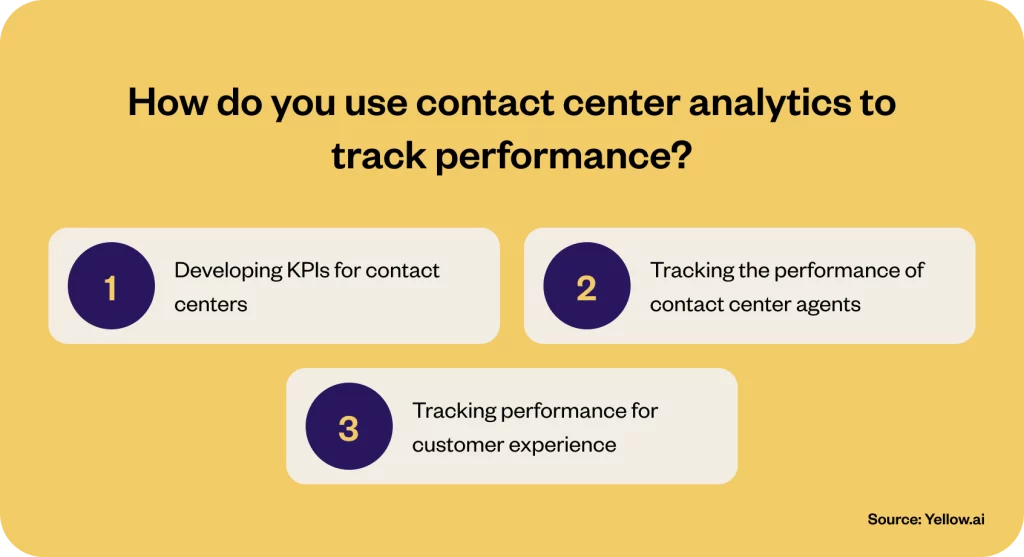
1. Developing KPIs for contact centers
Creating Key Performance Indicators (KPIs) is essential for monitoring and assessing the efficiency and effectiveness of contact center operations. These KPIs should encompass both quantitative and qualitative aspects of performance, including call resolution times, customer satisfaction scores, and the emotional tone of interactions. For example, metrics like Net Promoter Score (NPS), Customer Effort Score (CES), and Customer Satisfaction (CSAT) can provide insights into the customer experience. In contrast, traditional metrics such as average handle time and call transfer rates give a snapshot of operational efficiency.
Related read: 31 Call center metrics and KPIs to enhance the CX
2. Tracking the performance of contact center agents
Evaluating the performance of contact center agents goes beyond just measuring call durations or the number of calls handled. It involves analyzing the quality of interactions, such as how effectively agents resolve customer issues and how they impact customer sentiment. Businesses can use analytics software to assess each agent’s performance comprehensively, considering factors like problem-solving skills, customer feedback, and the ability to positively influence customer perceptions.
3. Tracking performance for customer experience
Customer experience is intricately linked to contact center interactions. Analytics provide a wealth of information about customer challenges and preferences. By analyzing conversations, businesses can track sentiment, understand customer needs, and identify service gaps. Predictive analytics further enhances this process by preempting customer issues, allowing for proactive service adjustments. This approach improves customer satisfaction and also informs strategic decisions, leading to a more effective and responsive contact center operation.
Related read: 10 Reasons why customer experience is important?
How to reduce customer problems with AI-driven analytical solutions?
Harnessing AI-driven analytical solutions is pivotal for reducing customer problems in contact centers. Here’s how these technologies can transform customer service experiences:
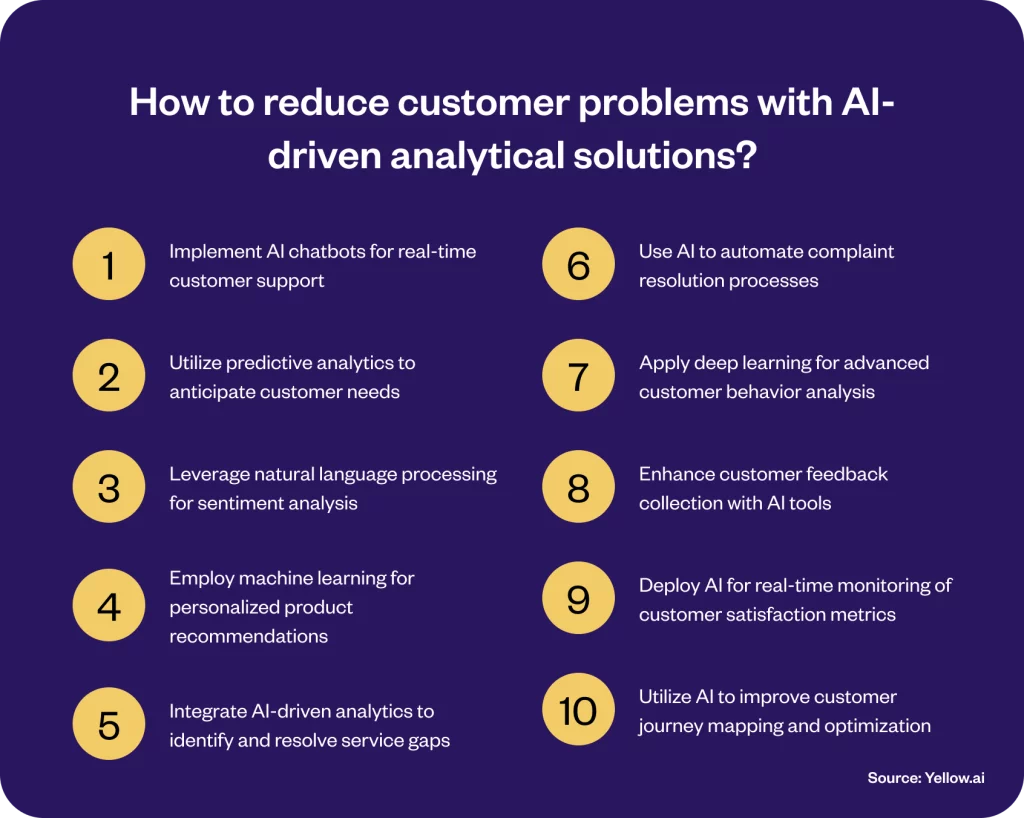
1. Implement AI chatbots for real-time customer support
Customers often face long wait times and seek quick resolutions to their queries. AI chatbots, like those powered by Yellow.ai, provide immediate assistance, handling common inquiries and issues in real time. They use machine learning to understand and respond to customer needs, ensuring fast and accurate support.
Related read: Customer service chatbots: Benefits and examples [2024]
By implementing AI chatbots, businesses can significantly reduce response times and improve customer satisfaction. These bots can resolve a wide range of issues without human intervention, leading to increased efficiency and reduced operational costs. For example, a retail company might use AI chatbots to handle frequent inquiries about order status or product availability, freeing up human agents to tackle more complex issues.
2. Utilize predictive analytics to anticipate customer needs
Anticipating customer needs can be challenging, but predictive analytics can analyze past interactions and behaviors to forecast future requirements. This proactive approach enables businesses to offer personalized solutions and prevent potential issues before they arise.
With predictive analytics, companies can tailor their services to individual customer preferences, enhancing the overall experience. For instance, a telecom provider might use predictive analytics to identify customers likely to face service disruptions and proactively offer solutions, thus preventing dissatisfaction and potential churn.
3. Leverage natural language processing for sentiment analysis
Understanding customer emotions and sentiments during interactions can be complex. Natural language processing (NLP) aids in analyzing verbal and written communication to gauge customer sentiment, providing insights into their experiences and satisfaction levels.
Related read: Customer sentiment analysis in 2024: How-to guide
NLP can help identify trends in customer sentiment, allowing businesses to adjust their strategies accordingly. For example, if sentiment analysis reveals that customers are consistently frustrated with a particular aspect of the service, the company can prioritize improvements in that area.
4. Employ machine learning for personalized product recommendations
Providing tailored experiences can significantly enhance customer satisfaction. Machine learning algorithms analyze customer data to generate personalized product or service recommendations, creating a more tailored experience.
This approach improves customer satisfaction and increases cross-selling and upselling opportunities. For instance, an e-commerce platform might use machine learning to recommend products based on a customer’s browsing history and purchase patterns, leading to increased sales and customer loyalty.
Related read: Ecommerce Automation: Benefits & Task You Can Automate
5. Integrate AI-driven analytics to identify and resolve service gaps
Identifying and addressing service gaps is crucial for maintaining high-quality customer service. AI-driven analytics can pinpoint areas of improvement across the customer journey, ensuring that businesses can swiftly address and rectify these gaps.
This proactive approach prevents minor issues from escalating into major problems, thereby maintaining high levels of customer satisfaction. For example, a utility company could use AI-driven analytics to detect patterns in service disruptions and address these proactively, reducing customer complaints.
6. Use AI to automate complaint resolution processes
Handling complaints efficiently is crucial for customer retention. AI can automate the resolution process, quickly identifying the nature of complaints and routing them to the appropriate channels or resolving them directly.
This automation speeds up resolution times and frees up human agents to focus on more complex issues. For instance, a financial institution might automatically employ AI to categorize and respond to common inquiries about account balances or transaction statuses, enhancing customer satisfaction and operational efficiency.
7. Apply deep learning for advanced customer behavior analysis
Understanding nuanced customer behaviors can lead to better service personalization. Deep learning algorithms analyze extensive datasets to uncover patterns and predict customer actions, allowing businesses to tailor their interactions and services.
This level of analysis can lead to highly personalized customer experiences, improving engagement and loyalty. For example, a streaming service might use deep learning to analyze viewing habits and recommend content that aligns with individual preferences, thus increasing user engagement.
8. Enhance customer feedback collection with AI tools
Collecting and analyzing customer feedback across multiple channels can be overwhelming. AI tools can streamline this process, gathering and synthesizing feedback from various sources to provide actionable insights.
Enhanced feedback collection helps businesses quickly identify and address customer concerns, improving product and service quality. For example, a hospitality business might use AI tools to aggregate and analyze customer reviews from different platforms to identify areas for improvement in their services or facilities.
9. Deploy AI for real-time monitoring of customer satisfaction metrics
Continuous monitoring of customer satisfaction is essential for maintaining service quality. AI systems can track satisfaction metrics in real time, alerting businesses to potential issues as they arise.
Real-time monitoring allows companies to address concerns promptly, preventing minor issues from escalating and negatively affecting customer perception. For instance, a telecommunications company might use AI to monitor network performance and customer feedback, enabling quick responses to service disruptions or coverage issues.
10. Utilize AI to improve customer journey mapping and optimization
Creating a seamless customer journey requires understanding each touchpoint and interaction. AI can map and analyze the entire customer journey, identifying bottlenecks and opportunities for improvement.
With AI-driven journey mapping, businesses can optimize interactions to enhance the customer experience, leading to increased satisfaction and loyalty. For example, a retail business might use AI to analyze shopping patterns and optimize the online and in-store journey, making it more intuitive and enjoyable for customers.
How Yellow.ai can help automate your customer service operation?
Yellow.ai’s prowess in AI-driven solutions transcends standard automation. Yellow.ai offers a nuanced approach to automated customer service operations. Here’s how their technology stands out, bringing specificity and depth to contact center management:
- Dynamic AI-powered virtual assistants: Yellow.ai’s AI-powered chatbots and voice agents are not just about handling queries; they adapt to customer moods and preferences, offering solutions that feel personal and thoughtful.
- Predictive customer journey mapping: Our platform goes beyond analytics. Our tools for predicting future customer behaviors and trends allow businesses to shape the customer journey proactively.
- Sentiment analysis with depth: Thanks to our smart Sentiment Analysis feature, Yellow.ai leverages advanced NLP to discern underlying customer emotions. This enables businesses to address not just the ‘what’ but the ‘why’ of customer interactions.
- Customized machine learning models: Instead of one-size-fits-all, Yellow.ai tailors machine learning algorithms to fit each business’s unique needs and challenges, ensuring more accurate and effective recommendations.
- Integrated analytics dashboard: Their solution provides an integrated view, combining various data points to offer comprehensive insights, enabling swift and informed decision-making.
For businesses looking to upgrade and automate their contact center operations with AI-driven efficiency, Yellow.ai offers a suite of solutions that not only automate but also intelligently adapt to evolving customer needs. Book a demo with Yellow.ai to experience how their technology can transform your customer service landscape.
The final thoughts
The transformative power of AI-driven solutions (like those offered by Yellow.ai) in contact center analytics is evident. These technologies are partners in navigating the complex landscape of customer interactions, providing insights and automation that redefine efficiency and satisfaction.
As we look to the future, the role of advanced analytics and AI in customer service is unmistakably pivotal. It’s about creating a symbiotic environment where technology and human insight merge to foster meaningful relationships. The journey doesn’t end with resolving customer issues; it evolves into understanding and anticipating needs, crafting experiences that resonate on a personal level, and continually adapting to the dynamic nature of customer expectations.
Integrating sophisticated analytics and AI into contact centers is a natural course in understanding and serving customers in this customer-centric era. With each interaction analyzed and every piece of feedback valued, businesses are set to exceed the evolving standards of customer service, paving the way for a future where every call, chat, or email is a step toward deeper customer connection and business growth.






















